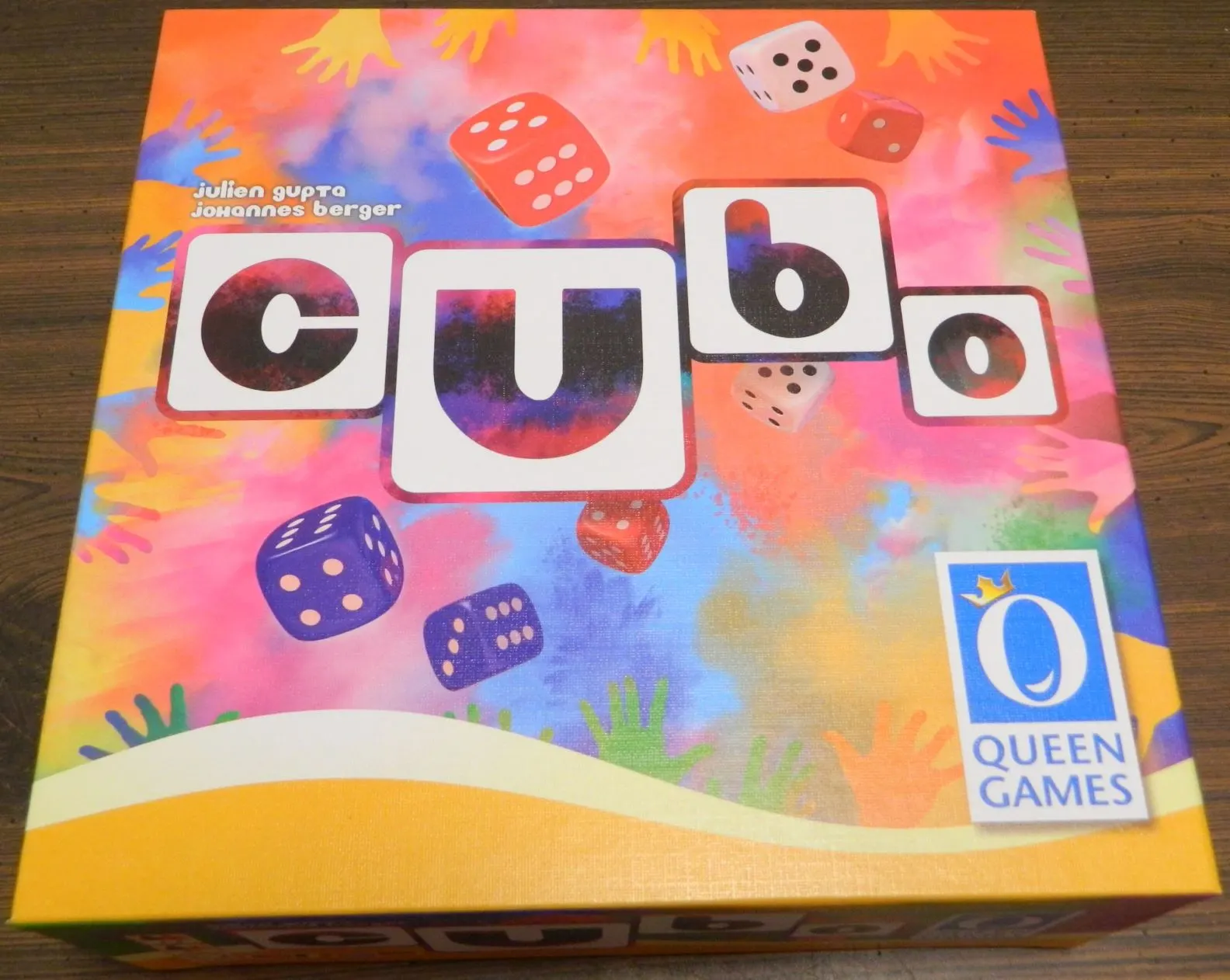Ever since the creation of the standard six sided dice there have been a number of different genres based around rolling dice. There are your typical Yahtzee style games where you try to roll the most valuable combination of dice between a couple rolls. There are press your luck and bluffing games like Liar’s Dice where the players bluff what numbers they rolled while trying to predict what the other players have rolled. There are also plenty of speed games where players race against one another in order to be the first to roll a particular combination. Today I am looking at the 2014 speed dice game Cubo which feels like a speed mechanic was applied to a game like Yahtzee where players have to figure out the best way to arrange their dice to maximize their score. Dice games aren’t my favorite genre, but I don’t mind trying out a new game from the genre every so often so I was curious what Cubo had to offer. Cubo relies on a lot of luck like most dice games, but it combines a bunch of different mechanics together into a solid satisfying experience that fans of speed dice games should enjoy.
How to Play Cubo
Setup
- Place the scoring board in the middle of the table. Sort the scoring chips by their type and place them on the corresponding sections of the scoring board.
- Place the game round board in the middle of the table. Place the round counters on the board with the numbers face up.
- Set two blue and two red dice in the center of the playing area.
- Each player takes a cover tile, one white die, four red dice, and four blue dice.
- The oldest player will start the game.
Playing the Game
Cubo is played over six game rounds. Each round begins with the current player flipping over the round counter for the current round. The current player will also roll the four dice lying in the center of the table. When everyone is ready the current player will say “Cubo” and the round will begin.
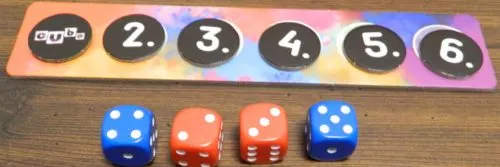
The players have turned over the token for the first round. They have also rolled the four center dice. The players are ready to begin the first round.
All of the players will begin the round by rolling all nine of their dice. The round will be played in real-time with all of the players playing at the same time. After rolling the dice the players can choose one of two different actions.
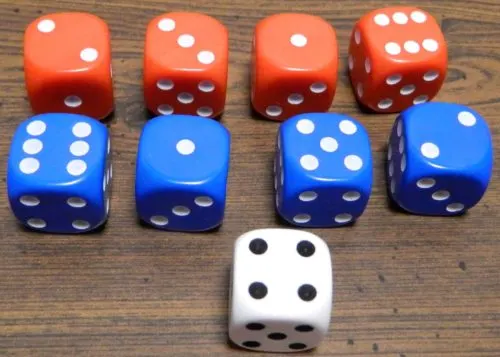
This player has rolled their nine dice. They can either choose to re-roll the dice or they can arrange their dice into a Cubo.
The first action that a player can take is arranging their rolled dice into a Cubo (a 3 x 3 square). Players must place the white die in the center of the square, but the red and blue dice can be placed in any other position. When placing the dice the goal is to create as many straights (three consecutive numbers) and trips (three of the same number) as possible in the three vertical and three horizontal rows that make up the square.
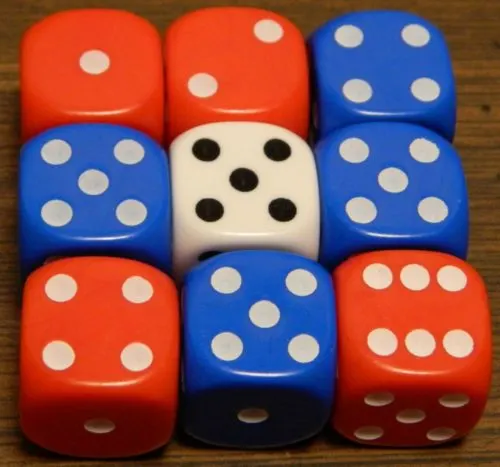
This player has arranged their dice into a Cubo. If they are happy with the Cubo they can lock it in.
If a player is satisfied with their Cubo they may place their cover tile on top of their dice and call out “Cubo”. This player may no longer rearrange their dice. The player who called “Cubo” will now be able to take one of the dice in the center of the table and place it on top of their cover tile. The dice should remain on the side that was rolled.
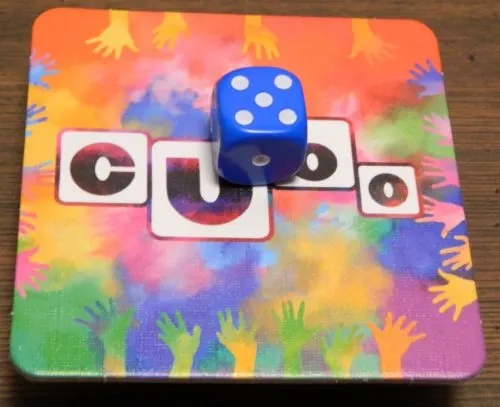
This player has completed their Cubo so they have placed the cover on top of their dice. They also choose to take the blue five.
The other action that a player can take is to re-roll their dice. If a player doesn’t like their dice roll or the Cubo they formed they can choose to re-roll all of their dice. The player must re-roll all of the dice as they don’t have the choice of keeping some of the dice and rolling others. They may re-roll their dice as many times as they want. Once the first player calls out “Cubo” though the rest of the players can no longer re-roll their dice. If a player has their dice in their hand when Cubo is called out they may roll the dice one more time. The players that haven’t called out Cubo yet will then have to arrange their dice into a Cubo. Each player will take one of the dice from the center of the table after they complete their Cubo.
End of Round and Scoring
Once all but one of the players have finished their Cubo and have taken one of the dice, the rest of the players will start a six second countdown. The last player has until the end of the countdown to finish their Cubo and place their cover on top of the dice. If they finish all of this before the countdown ends they will get to take one of the dice from the center and will score points. If they do not finish before the end of the countdown they will score zero points for the current round.
Each player will score points based on their own Cubo. All of the players will take the die they took from the center of the table. They may use this die to replace any of the other dice (except the white dice) in their Cubo. The die does not have to be the same color as the die it is replacing. It must stay on the side that was rolled though. The die that was replaced or the center die (if the player chooses not to use it) will be returned to the center of the table.
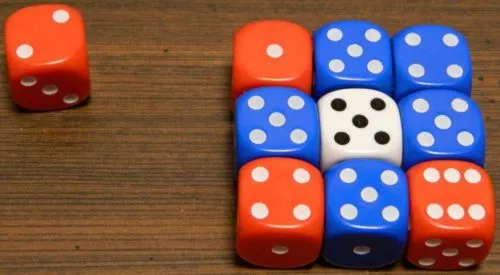
This player took a blue five from the center of the table. In order to increase their score they replaced the red two from the top middle space with the blue five. The red two will be added to the dice in the middle of the table.
Players will then score each of their vertical and horizontal rows separately. Players will score points as follows:
Each straight (three consecutive numbers in a row) will score points equal to the highest number in the straight. For example a 2, 3, 4 straight will be worth four points.
Each trips (three of the same number) will score points equal to the number on the dice. For example three fives will score five points.
If a player completes a straight or trips with all of the dice being the same color the number of points they score will be doubled. The white dice is considered both red and blue for determining whether the row scores the bonus points.
Each player will take scoring chips equal to the number of points they scored.
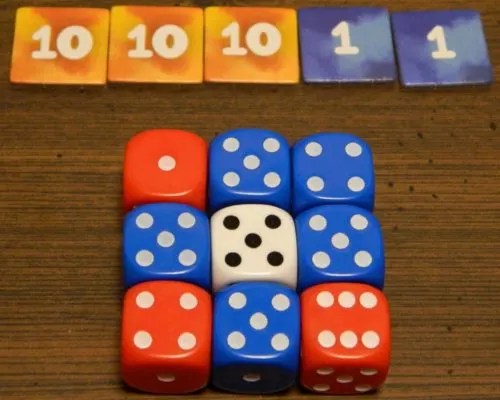
This player scored a total of 32 points as follows. The player will score 10 points for the middle row and the middle column as all of the dice are blue fives meaning their normal value of five is doubled because all of the dice are the same color. The player will also score six points for the last row and column because they are straights ending in a six.
The next player clockwise will be the start player for the next round.
End of Game
The game ends after the players complete scoring for the sixth round. The player who scored the most points will win the game. If multiple players are tied for the most points, the tied players will share the victory.
My Thoughts on Cubo
If I were to describe Cubo I would say that it feels like a combination of a number of different mechanics. The most obvious mechanic is the dice rolling as it is the main mechanic in the game. Like most dice rolling games a lot of the gameplay in Cubo revolves around rolling the dice and trying to get various combinations in order to score points. In a lot of ways Cubo kind of feels like Yahtzee and other similar games. The combinations that you have to roll are different, but the gameplay feels quite a bit like Yahtzee. Instead of rolling larger groups of the same number or in a row, in Cubo you are trying to roll a number of smaller trips and straights that you can arrange in a way to maximize your score.
The idea of creating a Cubo was arguably the most interesting element of Cubo. This is where the second mechanic, pattern recognition, comes into play. Basically a Cubo is a 3 x 3 square featuring nine different dice. The middle dice always has to be the white dice, but you otherwise can choose where you want to place the other eight dice. How you place the eight dice determines how many points you can score. After rolling your dice you need to analyze them quickly and try to find potential scoring opportunities. You need to look for three dice of the same number or three numbers in a row. Players should either in their head or physically arrange the dice into a Cubo to see how many different scoring opportunities they have with the dice they rolled. If they like the Cubo they come up with they can keep it and put pressure on the other players. If they don’t like it they will re-roll all of the dice and start over.
At first it may seem kind of odd that the game forces you to either keep or roll all of your dice. Most of these types of games allow you to pick and choose which dice you want to re-roll. Normally I would question this mechanic as I would think it would be better to be able to re-roll whichever dice you prefer. Based on personal experience though I know why this mechanic is in place. The first time I played Cubo I made an error in reading the rules as I didn’t see that you had to re-roll all of the dice. Thus players just re-rolled the dice of their choice. This lead to significant problems for the game. Without this rule players just re-rolled any dice that couldn’t be used in some combination that utilized sixes. There was no reason not to as you might as well try to create scoring sets with sixes as they score more points. This basically turned the game into a race of players trying to roll sixes as quickly as possible. This eliminated much of the speed mechanic and basically made it an exercise in who could roll the most sixes. It did lead to really high scores, but the gameplay was really dull. I would never play the game in this way again as it is considerably worse than how the game is supposed to be played.
You must make all of your decisions in the game quickly as the game’s final major mechanic is speed. The game doesn’t have an actual timer as your timer is the other players. All of the players have no idea about how much time they will ultimately get to roll and arrange their dice. Thus the players have to make decisions quickly. Players can take as much time as they want to roll and arrange dice until one of the players lock in their Cubo. At this point players can no longer re-roll dice so they have to deal with whatever they last rolled. Players still have time to arrange their dice, but they still need to think quickly because they never know when the round will end. When all but the last player has locked in their Cubo the last player has six seconds to finish or they will score no points for the round. If the last player took too much time thinking about what they should do they may have to rush to finish off their Cubo to have any chance of scoring points.
While some players aren’t going to like the speed mechanic it is necessary for the game. The time pressure makes the game a little stressful at times especially if you only have a couple seconds to finish your Cubo. Without the time limit though the game would be totally different. The key to doing well in Cubo comes down to quickly recognizing patterns in the dice you rolled and deciding quickly what you want to do. If you don’t make quick decisive actions you likely won’t do well in the game. In particular you don’t have the luxury of being able to keep rolling the dice in order to get a perfect roll. Once you have a set of dice that give you a couple different scoring opportunities you are best off arranging the dice how you want and locking them in. This prevents the other players from re-rolling their dice while also reducing the amount of time they have to think increasing the odds that they will make a mistake. If you are indecisive or re-roll your dice too often you will likely be stuck scoring few points as you will have to rush to arrange your dice in time. To do well in the game you need to be willing to make quick decisions and stick with them.
Cubo has some issues, but I had fun with the game. The gameplay is pretty simple, and the combination of the various mechanics work pretty well together. The idea of quickly trying to spot scoring opportunities and arranging them into a Cubo is fun. There is skill in quickly recognizing scoring opportunities and finding the best way of arranging them to maximize your points. This is all on a clock as you need to decide quickly so the other players don’t limit your options. Basically when arranging your Cubo you want to keep two things in mind. First you want to try and create as many scoring groups that utilize high numbers as possible as the groups score points for the highest valued dice. On top of that you want to try to create groups that utilize the same color. Doubling the score of a group of dice can add quite a few points to your final score. This adds some strategy between rounds as you get to take one of the center dice each round. Thus you can increase your number of dice in one of the colors making it more likely that you can receive this bonus. These might not be the deepest mechanics, but I found them to be enjoyable. People who like Yahtzee type dice games and don’t mind the speed mechanics should enjoy Cubo.
On top of this Cubo is quite easy to play. Basically the gameplay boils down to rolling the dice, analyzing whether you want to keep the dice or re-roll them, and finally arranging them into a Cubo and locking it in. The only mechanic that is even somewhat difficult is how you form a Cubo and how you score points in the game. These mechanics are pretty simple as well, but they take a little while to learn and get used to. Still I think the game could be taught to most people within just a couple minutes. The game has a recommended age of 8+ which seems right, but some kids even a little younger could probably enjoy the game. With the simple mechanics and the fact that the game utilizes speed mechanics it also shouldn’t come as much of a surprise that the game plays pretty quickly. I would guess that most games could be finished in around 20 minutes.
I had fun with Cubo. It is not the deepest game, but if you like speed dice games I think you can have fun with the game. There are a couple problems with the game though.
The biggest problem with the game shouldn’t come as much of a surprise as just like all dice games Cubo relies on a lot of luck. Players that roll well in the game are going to have a significant advantage in the game. Rolling well gives you two benefits. Obviously if you roll a lot of dice that can be arranged to score you points you likely will score more points than the other players. Rolling well also lets you finish your Cubo quicker. If your first roll is good you can immediately start assembling your Cubo while the other players are still trying to get a good roll. This gives you more time to analyze your options so you don’t make a mistake. It also allows you to finish quicker which limits the other players. You need to be smart in how you place your dice, but if you don’t roll well there isn’t much that you can do in the game.
While Cubo is only six rounds long there will be times where it is pretty obvious who is going to win before you even finish the game. This is because it is possible for players to score a lot of points in one round putting them considerably ahead of the other players. In most rounds the players’ scores will be within a couple of points of one another. There will be an occasional round though where one player scores considerably more or less than the rest of the players. As most rounds are usually pretty close this means that one really good or bad round will likely determine your odds of winning the game. If one player has a really good round it will be pretty hard to catch up. This can make the ending kind of anti-climatic in some games as you already know who is going to win before the game even ends. This usually won’t be an issue, but there will be games where it isn’t all that competitive.
As for the components I found them to be kind of hit or miss. First the new sealed copy of the game I bought was missing one of the dice. This is not a huge deal as it was easy enough to find a replacement dice. The dice in the game are not bad, but I wouldn’t call them premium dice either. They are pretty generic color dice. I think the biggest problem with the components is that a lot of them are kind of unnecessary. The game includes a lot of different cardboard pieces that weren’t really necessary for the game. The gameboard and the scoring tokens don’t really add anything to the game as you are likely better off just writing down each player’s score for the round. Even the cardboard covers aren’t all that important. In a lot of ways the cardboard pieces feel like they were added to make the game feel like more of a premium game so the publisher could charge more for it. If you have access to enough color dice you could theoretically make your own version of the game as the dice are pretty much all you need.
Should You Buy Cubo?
All in all Cubo is a pretty solid speed dice game. Like a lot of dice games you are trying to roll groups of dice that are either the same number or create a short straight. The catch is that you need to create a 3 x 3 square where you try to score points from as many of the six potential scoring options as possible. This is an interesting mechanic as it takes some skill to quickly realize your potential scoring options and arrange the dice to maximize your score. This is added to the speed element where you can force the other players into making quick decisions. The game is easy to play and yet there is some strategy as well. People who like these type of dice game will likely enjoy Cubo. Like all dice games though it still relies on a lot of luck as the player that rolls the best will have a big advantage in the game. Some games can also be blowouts, and most of the components feel kind of worthless.
If you don’t really like traditional dice games or speed games I don’t see Cubo being for you. If the game sounds interesting to you though I think you can have some fun with it. For a good price you could do much worse than Cubo.

